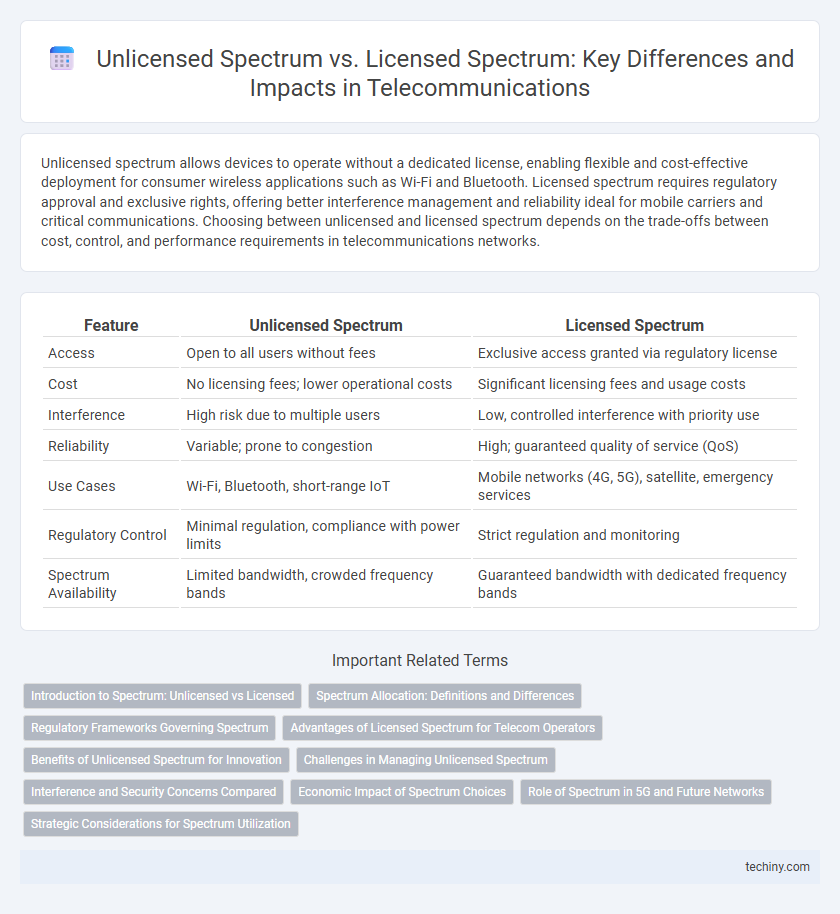Unlicensed spectrum allows devices to operate without a dedicated license, enabling flexible and cost-effective deployment for consumer wireless applications such as Wi-Fi and Bluetooth. Licensed spectrum requires regulatory approval and exclusive rights, offering better interference management and reliability ideal for mobile carriers and critical communications. Choosing between unlicensed and licensed spectrum depends on the trade-offs between cost, control, and performance requirements in telecommunications networks.
Table of Comparison
| Feature | Unlicensed Spectrum | Licensed Spectrum |
|---|---|---|
| Access | Open to all users without fees | Exclusive access granted via regulatory license |
| Cost | No licensing fees; lower operational costs | Significant licensing fees and usage costs |
| Interference | High risk due to multiple users | Low, controlled interference with priority use |
| Reliability | Variable; prone to congestion | High; guaranteed quality of service (QoS) |
| Use Cases | Wi-Fi, Bluetooth, short-range IoT | Mobile networks (4G, 5G), satellite, emergency services |
| Regulatory Control | Minimal regulation, compliance with power limits | Strict regulation and monitoring |
| Spectrum Availability | Limited bandwidth, crowded frequency bands | Guaranteed bandwidth with dedicated frequency bands |
Introduction to Spectrum: Unlicensed vs Licensed
Unlicensed spectrum allows multiple users to access specific frequency bands without individual licenses, fostering innovation and cost savings in applications like Wi-Fi and Bluetooth. Licensed spectrum involves exclusive rights granted by regulatory bodies, ensuring controlled interference and higher reliability crucial for mobile networks and critical communications. Understanding the distinction between unlicensed and licensed spectrum is essential for optimizing network performance and managing radio frequency resources effectively.
Spectrum Allocation: Definitions and Differences
Spectrum allocation in telecommunications distinguishes licensed spectrum as frequency bands granted by regulatory bodies for exclusive use by specific operators, ensuring controlled interference and reliable service quality. Unlicensed spectrum, by contrast, consists of frequency bands available for public use without exclusive rights, often leading to shared access environments with variable interference levels. The key differences lie in regulatory control, exclusivity of usage rights, and the impact on network performance and deployment costs.
Regulatory Frameworks Governing Spectrum
Regulatory frameworks governing unlicensed spectrum emphasize open access without individual licensing, promoting innovation and low-cost deployment for technologies like Wi-Fi and Bluetooth. Licensed spectrum operates under strict government allocation, requiring entities to obtain spectrum licenses to ensure interference control, priority access, and organized usage for critical services such as mobile networks and satellite communications. These frameworks balance spectrum efficiency, interference management, and equitable access to maximize overall telecommunication network performance.
Advantages of Licensed Spectrum for Telecom Operators
Licensed spectrum offers telecom operators exclusive frequency bands, significantly reducing interference and ensuring higher network reliability. This exclusivity enables enhanced security and better quality of service, critical for supporting advanced mobile technologies and IoT applications. Operators benefit from predictable performance and regulatory protection, facilitating long-term infrastructure investments and efficient spectrum management.
Benefits of Unlicensed Spectrum for Innovation
Unlicensed spectrum fosters innovation by enabling developers and startups to experiment without costly licensing fees, accelerating the deployment of new wireless technologies such as Wi-Fi, Bluetooth, and IoT devices. This open-access model encourages diverse applications and fosters competitive markets by lowering entry barriers for small businesses and research institutions. The flexibility and widespread availability of unlicensed spectrum drive rapid advancements in connectivity solutions, fueling the growth of smart cities, industrial automation, and consumer electronics.
Challenges in Managing Unlicensed Spectrum
Unlicensed spectrum faces significant challenges including interference from multiple devices operating without coordination, leading to degraded service quality and increased latency. Network operators struggle with unpredictable congestion and limited control over spectrum usage, complicating reliable communication and efficient resource allocation. Security vulnerabilities are also heightened due to the open-access nature of unlicensed bands, posing risks for sensitive telecommunications applications.
Interference and Security Concerns Compared
Unlicensed spectrum often faces higher interference levels due to multiple devices operating simultaneously without exclusive rights, leading to potential signal degradation. Licensed spectrum provides exclusive use by a single operator, significantly reducing interference and enhancing signal reliability. Security risks are more pronounced in unlicensed bands as unauthorized access and signal interception are harder to control compared to the regulated and monitored licensed spectrum.
Economic Impact of Spectrum Choices
Unlicensed spectrum facilitates innovation and competition by enabling numerous businesses to deploy wireless services with lower entry costs, driving economic growth in sectors such as IoT and Wi-Fi. Licensed spectrum provides operators with exclusive rights, ensuring reliable service quality and incentivizing substantial infrastructure investments, which supports large-scale commercial deployments and higher revenue generation. The balance between unlicensed and licensed spectrum allocation significantly influences market dynamics, affecting consumer prices, network expansion, and overall telecommunications sector profitability.
Role of Spectrum in 5G and Future Networks
Licensed spectrum offers exclusive frequency bands for 5G networks, ensuring high reliability, low latency, and enhanced security essential for critical applications. Unlicensed spectrum supports innovation by enabling flexible access and widespread IoT deployments but may encounter interference and limited QoS guarantees. Efficient management of both licensed and unlicensed spectrum is crucial to maximizing 5G capacity, enabling massive connectivity, and supporting future network evolution.
Strategic Considerations for Spectrum Utilization
Unlicensed spectrum offers businesses cost-effective access to radio frequencies without regulatory fees, enabling rapid deployment of wireless technologies such as Wi-Fi and IoT networks. Licensed spectrum provides exclusive frequency rights, ensuring minimal interference and more reliable performance for critical applications like 5G and emergency communications. Strategic utilization depends on balancing cost, control, interference management, and the specific needs of service reliability and coverage.
Unlicensed Spectrum vs Licensed Spectrum Infographic

 techiny.com
techiny.com